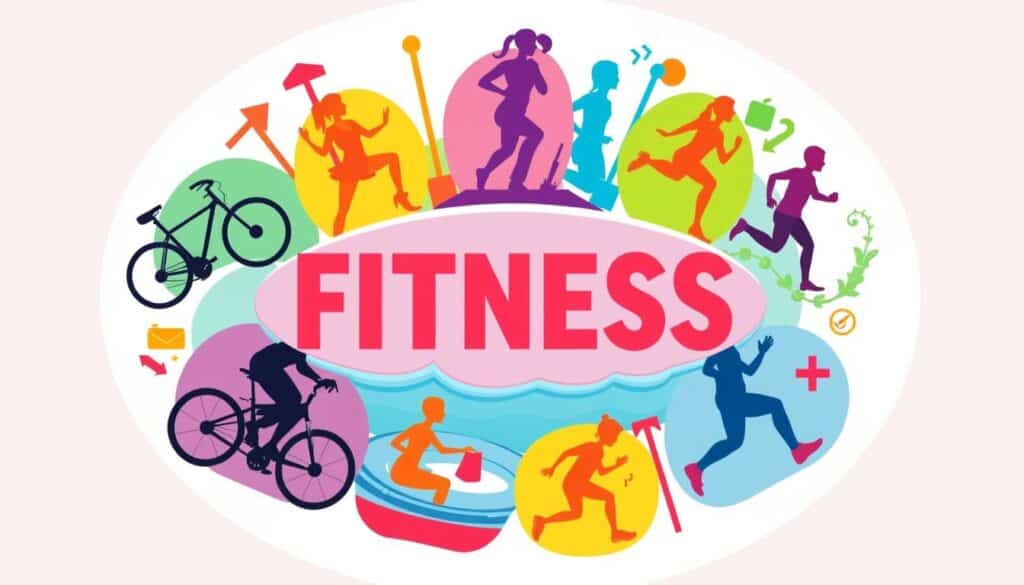(Hey! Some links in this post may be affiliate links — meaning I may earn a small commission if you buy through them, at no extra cost to you. As an Amazon Associate, I earn from qualifying purchases. I only share products I genuinely love and think you’ll find useful too. Read the full disclosure here).
Creating a comprehensive weekly fitness plan is a crucial step towards achieving your health and wellness goals. Whether you’re a seasoned exerciser or just starting your fitness journey, having a structured routine can make all the difference in staying motivated and consistent. In this article, we’ll guide you through the process of designing a weekly fitness plan that aligns with your objectives and keeps you engaged in the long run.
Contents
- 1 Understanding Your Fitness Goals
- 2 Assessing Your Current Fitness Level
- 3 Designing a Balanced Weekly Schedule
- 4 Selecting Activities You Enjoy
- 5 Time Management for Your Fitness Plan
- 6 Staying Flexible with Your Routine
- 7 Tracking Your Progress
- 8 Nutrition and Its Role in Your Fitness
- 9 Building Accountability
- 10 Overcoming Common Challenges
- 11 Evaluating and Adjusting Your Plan
- 12 FAQ
- 12.1 What are the key steps in creating an effective weekly fitness plan?
- 12.2 How can I define clear and realistic fitness goals?
- 12.3 How do I assess my current fitness level?
- 12.4 What should a balanced weekly fitness plan include?
- 12.5 How do I choose activities that I’ll enjoy and stick to?
- 12.6 How can I effectively manage my time for fitness?
- 12.7 How do I stay flexible and adjust my fitness plan as needed?
- 12.8 How can I track my progress and stay motivated?
- 12.9 How does nutrition play a role in my fitness plan?
- 12.10 How can I build accountability for my fitness plan?
- 12.11 How do I overcome common challenges in my fitness journey?
- 12.12 How do I evaluate and adjust my fitness plan over time?
Key Takeaways
- Establish clear fitness goals and set realistic milestones to track your progress.
- Assess your current fitness level through self-assessments or professional guidance.
- Incorporate a balance of strength training, cardio, and flexibility exercises into your weekly schedule.
- Prioritize activities you enjoy to maintain long-term engagement and adherence.
- Manage your time effectively and stay flexible to accommodate life’s demands.
Understanding Your Fitness Goals
Establishing clear fitness goals is the foundation for creating an effective physical activity plan that aligns with your health and wellness plan. Take the time to define your objectives and set realistic milestones to stay motivated and on track.
Define Your Objectives
Begin by writing down your fitness goals, whether it’s weight loss, building strength, improving cardiovascular endurance, or enhancing overall well-being. Consider the reasons behind these goals, such as improving your health, preparing for a specific activity, or simply feeling your best. Using the SMART (Specific, Measurable, Attainable, Relevant, Time-bound) method can help you set achievable objectives.
Set Realistic Milestones
- Aim for measurable targets, such as taking 10,000 steps daily or completing a certain number of workouts per week.
- Schedule weekly checkpoints to review your progress and adjust your goals as needed.
- Be open to modifying your fitness goals over time to match your changing capabilities and aspirations.
“Consistency, patience, and responsiveness to your body’s cues are key in maintaining a successful physical activity plan.”
By clearly defining your fitness objectives and setting realistic milestones, you’ll be well on your way to creating a health and wellness plan that you can stick to and enjoy.
Assessing Your Current Fitness Level
Before embarking on a new fitness regimen, it’s crucial to assess your current level of fitness. This not only helps prevent potential injuries but also allows you to track your progress effectively as you work towards an active lifestyle and a comprehensive physical activity plan.
Conduct a Self-Assessment
Start by evaluating your cardiovascular fitness. Consider tests like the 12-minute Cooper Test or the Rockport Walk Test, which can provide valuable insights into your aerobic capacity. To assess your total-body strength and stability, try a plank fitness test.
These self-assessment exercises can give you a baseline understanding of your current fitness level, empowering you to set realistic goals and develop a tailored workout plan.
Consider Professional Guidance
If you’re unsure about conducting a comprehensive self-assessment, it’s advisable to seek guidance from a fitness professional or healthcare provider. They can help you establish a safe starting point for your fitness journey and provide personalized recommendations based on your individual needs and goals.
By taking the time to carefully evaluate your current fitness level, you can lay the foundation for a sustainable and effective fitness regimen that will help you achieve your desired active lifestyle and physical activity plan.
Designing a Balanced Weekly Schedule
Crafting an effective weekly workout program requires striking the right balance between different fitness components. To achieve optimal results, it’s crucial to incorporate a mix of strength training, cardiovascular exercise, and flexibility work into your exercise routine.
Incorporate Strength, Cardio, and Flexibility
Aim for at least 150 minutes of moderate-intensity or 75 minutes of high-intensity cardio per week, such as brisk walking, cycling, or swimming. Complement this with two to three strength training sessions that target all major muscle groups. Don’t forget to include flexibility activities, like yoga or stretching, to maintain mobility and prevent injuries.
Factor in Recovery and Rest Days
- Allow 48 hours of recovery time between working the same muscle groups to prevent overtraining and promote muscle repair.
- Dedicate at least one day per week, such as Sunday, as a dedicated rest day for foam rolling, stretching, and light active recovery activities.
- Experiment with different workout schedules, such as full-body routines, upper and lower body splits, or push-pull-legs, to find what works best for your fitness level and goals.
Crafting a balanced weekly workout schedule is essential for maximizing the benefits of your exercise routine and avoiding burnout. By incorporating a mix of cardio, strength training, and flexibility, and factoring in adequate recovery time, you’ll be well on your way to a sustainable weekly workout program.
Remember, flexibility is key when designing your weekly fitness plan. Adapt your schedule based on your personal needs, preferences, and life circumstances.
Selecting Activities You Enjoy
When it comes to achieving your fitness goals and maintaining an active lifestyle, the key is finding workout routines that you genuinely enjoy. After all, the more you look forward to your exercise sessions, the more likely you are to stick to your workout schedule. Explore different fitness goals and active lifestyle options to discover the activities that truly resonate with you.
Explore Different Workout Styles
From high-intensity interval training (HIIT) to the soothing practice of yoga, the fitness world offers a diverse array of workout styles. Experiment with various modalities to uncover the ones that ignite your enthusiasm. Whether it’s the adrenaline rush of a dance class or the meditative flow of Pilates, the right workout can transform exercise from a chore to a cherished part of your daily routine.
Consider Group Classes or Solo Workouts
Some individuals thrive in the energy of group fitness settings, drawing motivation from the camaraderie and friendly competition. If you enjoy social interaction, joining a sports league or enrolling in group classes can be a fantastic way to stay active and engaged. Conversely, if you prefer a more solitary approach, home workouts or individual activities like running or cycling might be more appealing.
The key is to explore different options and find the activities that align with your personality and preferences. By selecting workouts you genuinely enjoy, you’ll be well on your way to a sustainable and rewarding fitness journey.
“When you find an exercise you enjoy, it’s no longer a chore. It’s a chance to challenge yourself, push your limits, and have fun.” – Unknown
Time Management for Your Fitness Plan
Effective time management is key to maintaining a consistent weekly fitness plan. Treat your workouts like important appointments by scheduling them in your calendar. Experiment with different times of day to find what works best for you, whether it’s early morning, lunchtime, or evening sessions.
Start with three exercise routine days per week and gradually increase as you build consistency. If time is limited, consider shorter, more frequent sessions or incorporate exercise into your daily activities, such as taking the stairs or walking during phone calls. Prioritizing your workouts in the morning when there are fewer distractions can lead to better results.
Dedicate Time for Workouts
- The CDC recommends adults get at least 150 minutes of moderate-intensity physical and two days of muscle-strengthening activity each week.
- Going beyond 150 minutes a week of moderate-intensity activity or 75 minutes a week of vigorous-intensity activity offers even more health benefits.
- Being realistic about your ideal workout schedule ensures it fits your life, goals, and priorities.
Prioritize Sessions in Your Day
Scheduling your active lifestyle sessions in your calendar and making them a priority can significantly improve your consistency. In fact, individuals who schedule their workouts are 65% more likely to stick to their exercise routine compared to those who do not.
“Treat your workouts like important appointments by scheduling them in your calendar.”
Additionally, taking advantage of downtime for productive tasks can lead to a 35% increase in overall task completion efficiency compared to not utilizing spare time effectively. Meal preparation in advance has also been shown to result in a 60% increase in adhering to a healthy eating plan.
Staying Flexible with Your Routine
Maintaining a weekly workout program is crucial, but it’s equally important to stay flexible. Be open to adjusting your fitness regimen as life changes or your body’s needs evolve. Whether it’s a shift in your work schedule or a fluctuation in your energy levels, don’t be afraid to tweak your physical activity plan.
Be Open to Adjustments
Life happens, and sometimes your carefully crafted workout routine may need a few tweaks. Perhaps you need to reschedule a session due to a last-minute meeting or a family obligation. Instead of skipping it altogether, find a way to fit it in later in the week. Flexibility is key to maintaining a consistent and sustainable fitness journey.
Recognize Signs of Burnout
Pushing yourself too hard can lead to burnout, so be mindful of the signs. If you find yourself constantly fatigued, lacking motivation, or experiencing persistent aches and pains, it might be time to adjust your approach. Listen to your body and make necessary changes to your routine to prevent burnout and injury.
“The secret of getting ahead is getting started. The secret of getting started is breaking your complex overwhelming tasks into small manageable tasks, and then starting on the first one.” – Mark Twain
Remember, a flexible and adaptable fitness regimen is more likely to become a lifelong habit. Stay open to adjustments, and don’t hesitate to take a break when needed. Your body and mind will thank you in the long run.
Tracking Your Progress
Monitoring your fitness goals, workout schedule, and overall health and wellness plan is crucial for maintaining motivation and making informed adjustments to your routine. Utilize a variety of tools to track your progress, from fitness apps and smartwatches to good old-fashioned journals.
Use Fitness Apps and Journals
Fitness apps and wearable devices can provide valuable insights into your activity levels, calorie burn, and workout performance. Apps like MyFitnessPal, FitNotes, and Strongly can help you monitor your fitness journey and identify areas for improvement. Complement these digital tools with a good old-fashioned journal, where you can record your workouts, feelings, and any notable changes in your body or energy levels.
Celebrate Small Victories
- Celebrate your small wins, such as completing a week of planned workouts or increasing your running distance.
- Recognizing these milestones can help you maintain a positive attitude and stay motivated on your fitness goals.
- Remember, even the smallest improvements are worthy of celebration and can provide the encouragement you need to keep pushing forward.
“The journey of a thousand miles begins with a single step.” – Lao Tzu
Stay focused on your workout schedule and celebrate each step along the way. With diligence and a positive mindset, you’ll be well on your way to achieving your health and wellness plan.
Nutrition and Its Role in Your Fitness
Proper nutrition is an essential component of a health and wellness plan and supports an active lifestyle and fitness regimen. Fueling your body with the right balance of macronutrients – lean proteins, complex carbohydrates, and healthy fats – can help you maximize your workout performance, support muscle recovery, and promote overall well-being.
Plan Your Meals for Success
Meal planning is a powerful strategy to ensure you have nutritious options readily available. Consider meal prepping your meals and snacks for the week, focusing on whole, unprocessed foods that will nourish your body. Consult a registered dietitian or nutritionist for personalized guidance on optimal meal planning to complement your fitness goals.
Stay Hydrated
Adequate hydration is crucial for overall health and exercise performance. Drink water throughout the day and before, during, and after your workouts. Replacing fluids and electrolytes lost through sweat can help maintain proper bodily functions, regulate body temperature, and support muscle recovery.
By prioritizing nutrition and staying hydrated, you can fuel your active lifestyle and enhance the effectiveness of your fitness regimen for a comprehensive health and wellness plan.
“Proper nutrition is the foundation of a successful health and wellness plan. It provides the essential nutrients to power your active lifestyle and support your fitness regimen.”
Building Accountability
When it comes to sticking to a weekly fitness plan or maintaining an active lifestyle, accountability is key. Partnering with a like-minded friend or family member who shares your exercise routine goals can be a powerful motivator. By working out together, you can hold each other accountable, provide encouragement, and celebrate your progress.
Joining a local fitness group or an online community can also help you stay motivated and on track. These supportive communities offer a space to share your achievements, seek advice, and receive the positive reinforcement needed to keep pushing forward. Consider working with a personal trainer or coach who can provide personalized guidance and ensure you remain accountable to your fitness objectives.
Find a Workout Buddy
Enlisting a workout buddy can significantly improve your chances of sticking to your weekly fitness plan. Look for someone who has similar fitness goals and is willing to commit to a regular exercise routine with you. Together, you can motivate each other, hold each other accountable, and make your workouts more enjoyable.
Join a Community or Online Group
Surrounding yourself with a supportive community can be a game-changer in your exercise routine journey. Whether it’s a local fitness group or an online community, these spaces provide a sense of belonging, encouragement, and shared experiences. By sharing your progress and challenges, you can inspire others and receive the motivation you need to stay on track with your active lifestyle.
“The secret of getting ahead is getting started. The secret of getting started is breaking your complex overwhelming tasks into small manageable tasks, and then starting on the first one.” – Mark Twain
Overcoming Common Challenges
Maintaining a consistent weekly workout program can be challenging, but with the right strategies, you can overcome common obstacles and stay on track with your fitness goals. Whether it’s addressing motivation dips or navigating busy schedules, embracing a flexible and proactive mindset can help you sustain your physical activity plan for the long haul.
Addressing Motivation Dips
It’s natural to experience moments of low motivation, but it’s important to have a plan in place to reignite your passion for fitness. Remind yourself of the reasons you started your exercise journey and the benefits you’ve already experienced. Creating a motivating playlist or podcast list can also provide a boost during your workouts.
- Reflect on your original fitness goals and the progress you’ve made.
- Curate a playlist of upbeat, energizing music to enjoy during your workouts.
- Find inspiring podcasts or audiobooks that discuss the importance of physical activity.
Strategies for Busy Schedules
When life gets hectic, it’s essential to have a plan to incorporate physical activity into your daily routine. Consider breaking exercises into shorter sessions throughout the day, such as “exercise snacks” of 10 minutes. Remain flexible with your workout times and locations, and always have a backup plan in case your original schedule is disrupted.
- Identify at least three 30-minute time slots in your daily routine for physical activity.
- Explore options like walking meetings, taking the stairs, or doing bodyweight exercises during breaks.
- Be willing to adjust your weekly workout program as needed to accommodate changes in your schedule.
By addressing motivation dips and adapting to busy schedules, you can overcome common challenges and maintain a consistent physical activity plan that aligns with your long-term fitness goals.
Evaluating and Adjusting Your Plan
Regularly assessing your weekly fitness plan is crucial to ensuring it remains effective and aligned with your evolving health and wellness goals. Schedule periodic reviews, such as monthly or quarterly, to evaluate your progress and identify areas for improvement. Be open to making changes based on your fitness level, interests, and lifestyle.
If certain aspects of your plan are not producing the desired results, don’t hesitate to make adjustments. This could involve trying new activities, increasing the intensity of your workouts, or modifying your schedule to better fit your needs. Remember, a successful fitness plan is one that you can maintain long-term, so continuous evaluation and adaptation are key to sustained progress and enjoyment.
By regularly reviewing your fitness plan and being willing to make changes, you can stay motivated, engaged, and on track towards achieving your health and wellness objectives. The process of evaluating and adjusting your weekly fitness is an essential part of maintaining a healthy and balanced lifestyle.
FAQ
What are the key steps in creating an effective weekly fitness plan?
The key steps include setting clear objectives, assessing your current fitness level, designing a balanced weekly schedule, selecting enjoyable activities, managing your time effectively, staying flexible with your routine, tracking progress, considering nutrition, building accountability, overcoming common challenges, and regularly evaluating and adjusting your plan.
How can I define clear and realistic fitness goals?
To set effective goals, use the SMART (Specific, Measurable, Attainable, Relevant, Time-bound) method. Write down your goals and the reasons behind them, such as improving health or fitness for specific activities. Schedule weekly checkpoints to review progress and adjust goals as needed.
How do I assess my current fitness level?
Before starting a new fitness routine, it’s important to assess your current fitness level. This can include tests like the 12-minute Cooper Test or the Rockport Walk Test for cardiovascular fitness, and a plank fitness test for total-body strength and stability. Seeking guidance from a fitness professional or healthcare provider can also help establish a safe starting point.
What should a balanced weekly fitness plan include?
A well-rounded fitness plan should include a mix of cardiovascular exercise, strength training, and flexibility work. Aim for 150 minutes of moderate-intensity or 75 minutes of high-intensity cardio per week, along with two strength training sessions. Don’t forget to incorporate rest days for proper recovery.
How do I choose activities that I’ll enjoy and stick to?
Choosing enjoyable activities increases the likelihood of sticking to your fitness plan. Experiment with various workout styles, such as HIIT, yoga, or dance classes, and consider whether you prefer group settings or solo workouts. The key is to find activities that fit your personality and preferences.
How can I effectively manage my time for fitness?
Effective time management is crucial for maintaining a consistent fitness routine. Treat workouts like important appointments by scheduling them in your calendar. Experiment with different times of day to find what works best for you, and start with three workout days per week, gradually increasing as you build consistency.
How do I stay flexible and adjust my fitness plan as needed?
Flexibility is key to maintaining a long-term fitness routine. Be prepared to adjust your plan based on life events, work schedules, or changes in your fitness level. Listen to your body and recognize signs of burnout. Adapt your exercises or intensity levels as needed to prevent boredom and continue challenging yourself.
How can I track my progress and stay motivated?
Monitoring your progress helps maintain motivation and allows you to make informed adjustments to your plan. Utilize fitness apps, smartwatches, or heart rate monitors to track metrics like steps, calories burned, and workout duration. Keep a journal to record your workouts, how you feel, and any improvements in strength or endurance. Celebrate small victories to maintain a positive attitude.
How does nutrition play a role in my fitness plan?
Proper nutrition is essential for supporting your fitness goals and overall health. Plan balanced meals that include lean proteins, complex carbohydrates, and healthy fats to fuel your workouts and aid in recovery. Stay hydrated by drinking water throughout the day and during exercise. Consult a nutritionist or dietitian for personalized advice on optimizing your diet.
How can I build accountability for my fitness plan?
Accountability can significantly increase adherence to your fitness plan. Partner with a friend or family member who shares similar goals, join local fitness groups or online communities, or work with a personal trainer or coach who can provide guidance and hold you accountable. Sharing your progress on social media or with a small group of supportive friends can also help maintain motivation.
How do I overcome common challenges in my fitness journey?
Anticipate and prepare for common challenges to maintain consistency in your fitness routine. To address motivation dips, remind yourself of your goals and the reasons why you started exercising. Create a motivating playlist or podcast list to enjoy during workouts. For busy schedules, break exercises into shorter sessions throughout the day or have a backup plan when your original schedule is disrupted.
How do I evaluate and adjust my fitness plan over time?
Regularly assess your fitness plan to ensure it remains effective and aligned with your goals. Schedule monthly or quarterly reviews to evaluate your progress and identify areas for improvement. Be open to making changes based on your evolving fitness level, interests, and lifestyle. If certain aspects of your plan aren’t working, don’t hesitate to adjust them, such as trying new activities, increasing workout intensity, or modifying your schedule.
Unlock Your True Potential
Ever wondered how to tap into your hidden creative genius and elevate your cognitive abilities? The Genius Wave combines cutting-edge binaural beat technology with neuroscientific insights to help you think sharper, learn faster, and attract more opportunities. Endorsed by former NASA neuroscientists, this program is designed to seamlessly fit into your daily routine and transform the way you approach challenges and opportunities.
👉 Click here to learn more about The Genius Wave and how it can elevate your life!












